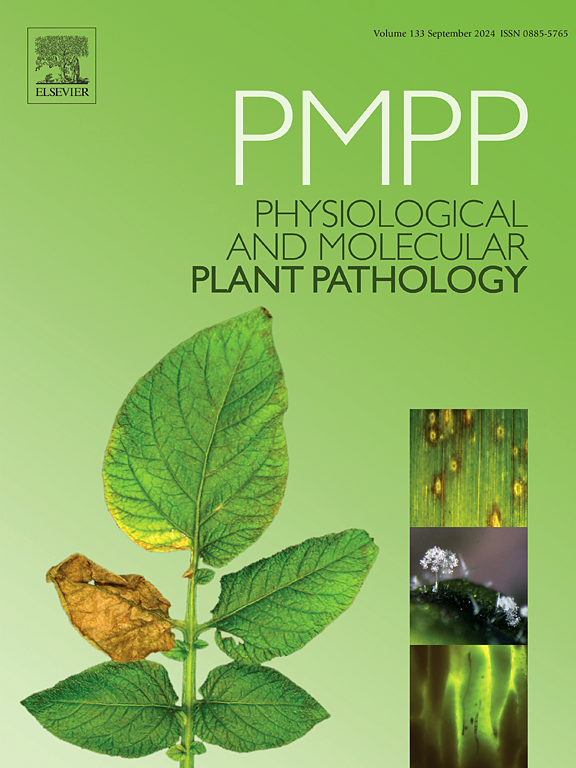Insight into the efficient transmission of cucurbit aphid-borne yellows virus (Polerovirus CABYV) by Aphis gossypii glover in bitter gourd
IF 2.8
3区 农林科学
Q2 PLANT SCIENCES
引用次数: 0
Abstract
The Polerovirus cucurbit aphid-borne yellows virus (CABYV) infecting bitter gourd was efficiently transmitted, manifesting in symptoms like leaf cupping, complete yellowing, chlorotic patches, and orange discoloration of young leaves, accompanied by vein thickening. Older leaves exhibited dark green mottling, yellowing along the margins, and a leathery texture. In field conditions, the aphid population (8.95 per plant) and CABYV incidence (85.6 %) were the highest in Coimbatore district of Tamil Nadu, while the greatest yield loss of up to 72.38 % occurred in Erode district. Molecular characterization confirmed the presence of CABYV in 19 out of 23 plant samples collected from various locations in Tamil Nadu through PCR. The aphid species Aphis gossypii was identified via morphological traits and PCR with MtCOI primers. Aphids required a minimum of 30 min for the acquisition access period (AAP) to become viruliferous, resulting in 30 % transmission of CABYV. The inoculation access period (IAP) of 30 min for viruliferous aphids led to 46.67 % transmission, with a gradual increase in transmission percentage as IAP increased. At 7 h (h) of both AAP and IAP, 100 % transmission was observed. A single viruliferous aphid transmitted CABYV in 33.33 % of cases, while a minimum of ten aphids was necessary for complete transmission. Aphids successfully retained and transmitted CABYV for at least five days, with transmission being sporadic. Despite its significance, no previous studies have investigated the virus-vector interaction in CABYV transmission. This study offers the first comprehensive analysis of CABYV transmission dynamics through Aphis gossypii, providing valuable new insights into its epidemiology.
瓜蚜传黄病毒(Polerovirus, CABYV)经棉蚜手套在苦瓜中有效传播的研究
感染苦瓜的瓜蚜黄毒(CABYV)传播效率高,表现为叶片火罐、完全发黄、幼叶褪绿斑块、橙色变色,并伴有静脉增厚。老叶呈深绿色斑驳,边缘泛黄,质地坚韧。田间条件下,泰米尔纳德邦哥印拜陀地区蚜虫数量最多(8.95只/株),CABYV发病率最高(85.6%),而罗德地区产量损失最大(72.38%)。从泰米尔纳德邦不同地点采集的23份植物样本中,有19份通过PCR证实了CABYV的存在。利用MtCOI引物,通过形态特征和PCR对棉蚜进行鉴定。蚜虫至少需要30分钟的获取获取期(AAP)才能变得具有毒性,导致30%的CABYV传播。毒蚜接种准入期(IAP)为30 min时,传播率为46.67%,随着准入期的增加,传播率逐渐增加。在AAP和IAP作用7 h时,均观察到100%的传输率。单个毒蚜传播CABYV的病例占33.33%,而完全传播至少需要10只蚜虫。蚜虫成功地保留和传播CABYV至少5天,传播是散发的。尽管具有重要意义,但之前没有研究调查CABYV传播中的病毒-载体相互作用。本研究首次全面分析了CABYV在棉蚜中的传播动态,为其流行病学研究提供了有价值的新见解。
本文章由计算机程序翻译,如有差异,请以英文原文为准。
求助全文
约1分钟内获得全文
求助全文
来源期刊
CiteScore
4.30
自引率
7.40%
发文量
130
审稿时长
38 days
期刊介绍:
Physiological and Molecular Plant Pathology provides an International forum for original research papers, reviews, and commentaries on all aspects of the molecular biology, biochemistry, physiology, histology and cytology, genetics and evolution of plant-microbe interactions.
Papers on all kinds of infective pathogen, including viruses, prokaryotes, fungi, and nematodes, as well as mutualistic organisms such as Rhizobium and mycorrhyzal fungi, are acceptable as long as they have a bearing on the interaction between pathogen and plant.

 求助内容:
求助内容: 应助结果提醒方式:
应助结果提醒方式:


